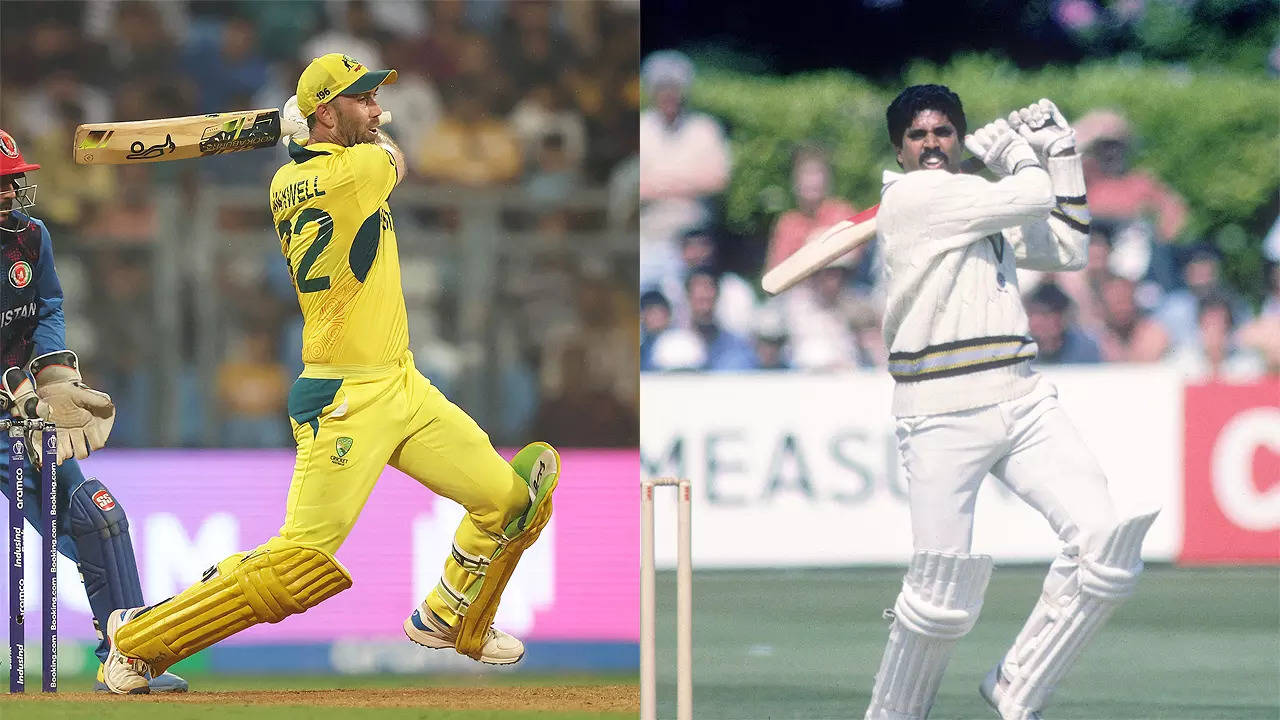The Innings
While Kapil’s 175 came in the first innings, Maxwell scored that double hundred in chase. There is a general consensus that chasing a target is tougher than setting a target. For example, in the ODI cricket history, 2,539 hundreds have been scored in 47,001 matches while batting first – an average of 18.50 innings per hundred. In chases, only 1,886 hundreds have been scored in 42,360 innings – an average of 22.46 innings per hundred. Also, Maxwell’s 201 was the first-ever double hundred in the second innings of a men’s ODI. In comparison, Kapil’s 175 was also the highest individual ODI score then. And we need to take into account how rare individual hundreds were in the 1980s. In the 1983 World Cup, for example, only 8 hundreds were scored in 27 matches. The ongoing edition has already seen 32 hundreds in 40 matches.The Situation
When Kapil came to the crease, India were tottering at 9 for 4 and they kept losing wickets after that. Fifth wicket fell for 17, sixth for 77, seventh for 78, and eighth for 140. But Kapil kept plundering boundaries from one end and took India to 266/8, a good enough total that they defended by 31 runs.
Maxwell entered the picture when Australia lost two wickets in consecutive balls and were reduced from 49-2 to 49-4. The first ball Maxwell faced was a hat-trick ball, which he somehow survived. Then he saw Australia getting reduced to 91-7. Australia still needed 201 runs to win, which they achieved without losing another wicket.
The Opposition
Zimbabwe were the surprise package of the 1983 World Cup. They were playing in their maiden World Cup. In fact, they made their ODI debut in the 1983 World Cup itself and upset Australia in the first game. That remained their only win in the tournament, though. They had some good first-class cricketers in their line-up but they didn’t have international experience and that showed.
Afghanistan of 2023 aren’t a surprise anymore. Their wins aren’t termed upsets. A side full of cricketers with brilliant T20 credentials, this World Cup they have shown their growth in ODI cricket. Going into the match against Australia, they had already registered wins against three past champions – England, Pakistan and Sri Lanka – in this edition. They were strong contenders for a semi-final spot.
The Contribution
It tells us the extent of the knock’s importance in the team’s victory. Kapil scored 175 out of India’s 266 runs to have a contribution of 65.79 percent. Maxwell’s contribution was slightly better. His 201 made up 68.6 percent of Australia’s 293. But if we calculate from the point of their arrival, Kapil’s contribution rises to 68.09 percent and Maxwell’s just flies through the roof with a humongous 82.38 percent.
The Physical
This is probably the biggest point of difference. Kapil remained completely fit throughout the innings and even bowled 11 overs while defending the total. Maxwell, on the other hand, was severely hampered by cramps and could hardly move his front leg for the later part of his innings – 147 runs onwards, to be specific.
The Specialisation
While both Kapil and Maxwell are categorized as all-rounders, there is a difference in their primary roles. Kapil was primarily a fast bowler who could bat well. Maxwell, on the other hand, is a batsman who can bowl.
The Ball
Though the ODI cricket is now synonymous with the white balls, the 1983 World Cup was played with the red ones. And that makes a significant difference. The red balls provide more assistance to the bowlers in comparison to the white balls. Also, under current playing conditions, new balls are used from both ends, keeping the ball hard for longer periods and reducing the possibility of reverse swing. Initially, the white ball swings more than the red one but once it loses shine, it doesn’t swing at all, while the red ball provides swing for a longer period and assists reverse swing.
The Conditions
There are very few sports that are as affected by conditions as cricket. From wind to temperature and grass to soil, everything makes a difference. On that day at Tunbridge Wells, the site of Kapil’s legendary knock, the pitch provided a lot of movement and bounce to seamers. To this day, seaming conditions are kryptonite for Indian batters. What Maxwell faced at Wankhede in Mumbai was good batting conditions further aided by dew.
The Conclusion
Inconclusive. But, let’s accept that both these innings were great. And we know that greatness is an abstract concept that can’t be measured. Instead, let’s honour these great innings by putting them side by side and not one above another.
For all the latest Sports News Click Here
For the latest news and updates, follow us on Google News.


